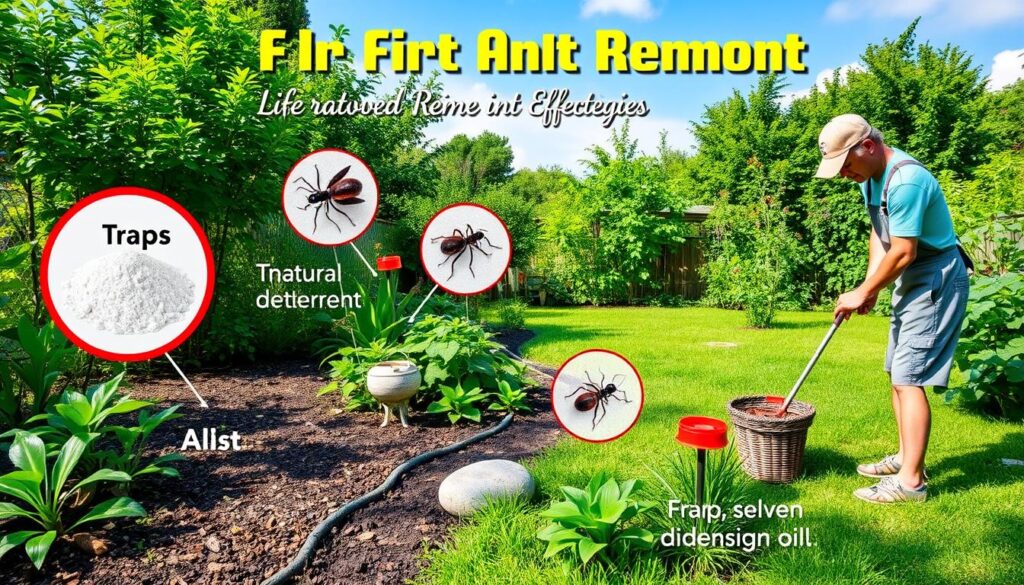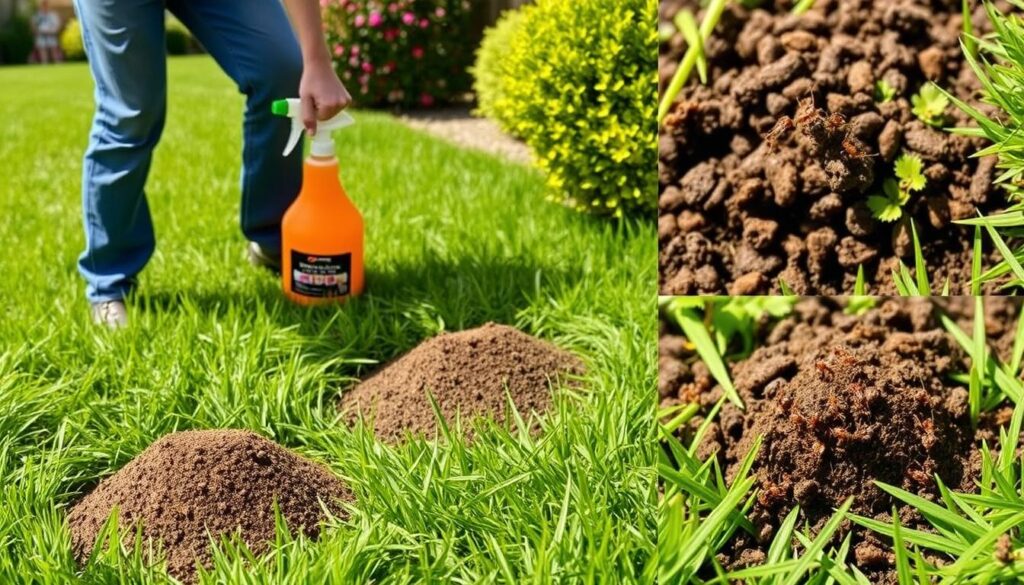Fire ants are a growing problem in homes and outdoors. They make safe, enjoyable spaces hard to maintain. They sting painfully and act aggressively. This can make your peaceful backyard stressful. We will talk about ways to get rid of these pests, keeping your yard free from them. It’s important to act early and use the right methods to fight fire ant invasions. Knowing how they live can help you stop them quickly.
Table of Contents
ToggleKey Takeaways
- Fire ants can cause painful stings and are aggressive in nature.
- Effective fire ant removal is crucial for a pleasant outdoor environment.
- Understanding their behavior aids in effective pest elimination.
- Early intervention can prevent more extensive infestations.
- Explore various methods for successful insect extermination.
Understanding Fire Ants and Their Behavior
Fire ants are quite interesting, famous for their complex behaviors and society structure. Getting to know how they behave helps both homeowners and experts handle infestations better. So, learning about fire ants shows us why it’s essential to deal with them swiftly.
Characteristics of Fire Ants
Fire ants are generally small, their size varies between 1/8 and 1/4 inch, and they have a reddish-brown color. They have strong mandibles and a stinger for defense. A typical colony has thousands of ants, including a queen focused on making more ants.
Their aggressive defense of the nest makes them tough for pest control to handle.
- Colony Structure: A colony usually has workers, males for breeding, and queens.
- Reproduction: A queen can lay thousands of eggs daily, causing fast growth.
- Aggressive Behavior: Fire ants attack anyone who comes close, which can endanger people, pets, and farm animals.
Why Fire Ants Are Considered Pests
Fire ants create problems in homes and farms. Their nests ruin gardens and landscapes, damaging plants. Moreover, they threaten farm animals, causing financial loss to farmers. Fire ant stings are painful and might lead to allergic reactions in some folks.
| Impact | Examples |
|---|---|
| Gardening | Damage to flowers and vegetables |
| Agricultural | Threat to crops and livestock |
| Health | Stings can cause pain and allergic reactions |
Signs of a Fire Ant Infestation
Knowing how to spot an infestation is key to ant control. Fire ants form big colonies quickly. This can become a big problem fast if not handled. It’s good to know about their mounds and behaviors. This way, homeowners can act fast.
Identifying Fire Ant Mounds
Usually, seeing fire ant mounds means ants are around. These mounds differ in size and shape. This depends on things like how wet the soil is and how old the colony is. Here’s what to look out for:
- Size: Mounds can be a few inches to a few feet tall.
- Shape: Mounds usually look like uneven piles of dirt.
- Location: You’ll find mounds in sunny places, often by buildings or greenery.
- Soil Type: The look of mounds can change with different soils and moisture.
Other Indicators of Infestation
There are other signs besides mounds that hint at fire ants. Noticing these early can stop bigger problems:
- Worker Ants: If you see ants alone, mainly looking for food, their nest might be close.
- Swarming Activity: Swarms in spring show ants are reproducing, which usually means more mounds.
- Damage to Plants: Ants keeping aphids on plants can mean nearby ant nests.
Fire Ant Removal: Effective Strategies
Getting rid of fire ants involves choosing from many strategies. It depends on what you prefer and your situation. Knowing all methods, from usual pest control to natural solutions, lets you pick the right one. This includes both regular techniques and green alternatives for controlling fire ants. If you are looking for the best Website, you can Visit here for more information: 除紅火蟻
Traditional Methods
There are several traditional ways to fight pests, each with pros and cons. Let’s look at some common ones:
- Baiting: This uses bait stations with poison. Worker ants take the bait to their colony, aiming at the queen.
- Insecticide Treatments: Spraying liquid poisons on mounds or nearby can work fast. However, it might harm good insects too.
- Mound Treatments: Applying poisons straight to the ant mound gets the ingredients right into their nest.
Natural Remedies for Fire Ant Control
If you worry about chemicals, there are natural options. These safe choices work well:
- Diatomaceous Earth: Putting this powder around infested areas breaks the ants’ outer layer, killing them by dehydration.
- Boiling Water: Dumping hot water on the mounds kills many ants. Yet, be careful not to harm plants.
- Vinegar Solutions: A mix of vinegar and water keeps ants away when sprayed on their paths. It messes with their direction and makes them leave.

Picking the right method to get rid of fire ants lowers infestations. It also respects personal choices and the environment. Look at all options to see which fits your needs and way of life best.
Choosing the Right Insecticide Treatment
Picking the right insecticide is key to controlling fire ants effectively. The best choice will kill off ants and keep them from coming back. It’s important to know about different insecticides and how to use them safely. This makes a big difference in getting rid of pests.
Types of Insecticides Available
There are many kinds of insecticides to choose from, each working differently. Here are the main types:
- Granular Insecticides: You spread these on infected spots. When watered, they go deep into ant hills.
- Liquid Insecticides: These are sprayed right on mounds or around them. They work fast and get absorbed quickly.
- Bait Formulations: Baits lure in ants that take the poison back to their home, hitting the problem at its source.
How to Apply Insecticides Safely
It’s critical to use insecticides without harming yourself or the planet. Here’s what to do to stay safe:
- Wear gear like gloves, masks, and goggles to avoid contact.
- Put down the insecticide when the air is still. This ensures it sticks where you need it.
- Always use the amount the label says and follow its directions. This helps in being effective and safe.
- Keep insecticides away from water to protect fish and other water life.
By following these tips, you’ll make your ant treatment work better. Plus, you’ll keep your home and nature safer.
Mound Destruction Techniques
Effectively managing fire ant problems means using specific tactics to destroy their mounds. It’s essential to know different ways to get rid of fire ant mounds for better pest control. Here, you’ll learn about the top methods for taking down fire ant homes.
Effective Methods for Destroying Mounds
There are many ways to fully remove fire ant mounds. The best method depends on the size and place of the mound. Here, we’ve listed some of the best techniques to consider:
- Direct Mound Drenching: This means pouring insecticide right onto the mound. A good soaking gets the poison deep inside, killing the queen and other ants.
- Physical Excavation: In this approach, you dig up and get rid of the whole mound. It takes a lot of work but removes the colony, perfect for big mounds.
- Using Boiling Water: Dumping boiling water on the mound can kill the ants and their home quickly. It works great for smaller mounds.
To truly destroy a mound, you must target the queen. If the queen survives, the colony can rebuild itself. A mix of these methods can help completely remove fire ant mounds.
Preventing Future Ant Infestations
To stop ant infestations, taking early actions is crucial. You can do this by focusing on how you arrange your garden and making areas where ants won’t want to live. By doing so, you reduce the chance of ants making a home in your yard. These steps can lead to successful control of pests outside.
Creating Ant-Resistant Landscapes
When you design your garden with ants in mind, you can keep them away. Think about these methods:
- Proper irrigation management: Make sure your yard doesn’t stay wet because ants are drawn to moisture.
- Selecting ant-repellent plants: Use plants like mint or rosemary that ants don’t like.
- Maintaining a clean yard: Keep your garden clean by removing trash and dead plants to give ants fewer places to hide.
- Utilizing barriers: Use sand or gravel to block ants from making nests in your garden.
Using these tips won’t only help stop ants from coming but also make your yard look better and healthier. Staying consistent with these outdoor pest control efforts is the secret to a yard without pests.

Outdoor Pest Management Best Practices
Successful outdoor pest control means always working on your yard and watching for pests. By using the right strategies, you can greatly lower the chance of fire ant problems. This will make your outdoor areas better.
Regular Yard Maintenance Tips
Keeping your yard clean is crucial for reducing pest homes. Here are some top tips:
- Regularly cut the grass and trim shrubs to eliminate hiding spots.
- Remove leaf litter and debris, which can attract pests.
- Clear food waste and pet droppings promptly to minimize food sources.
- Check and maintain flower beds, ensuring they are well-kept.
- Seal cracks and crevices in walkways and patios to reduce access points.
Monitoring and Early Detection
Good pest watching catches problems early. Doing regular checks lets you find fire ants or other pests early:
- Conduct weekly or bi-weekly checks around your yard.
- Utilize traps strategically placed to monitor pest activity.
- Keep an eye out for signs of ants, like mounds or trails.
- Consider reporting unusual pest activities to local pest control professionals for advice.
Using Ant Deterrents Effectively
Ant deterrents are key in managing pests, especially fire ants, near your home. There are many kinds of products that can help keep your space bug-free. You can choose from chemical or natural options, depending on your preferences and safety needs. In this section, we’ll look at some top choices and how to use them.
Best Products for Deterrence
Several brands are known for their success in fighting fire ants. Here’s a table with some popular choices:
| Product Name | Type | Active Ingredients | Effectiveness | Safety for Pets/Children |
|---|---|---|---|---|
| Terro Liquid Ant Baits | Chemical | Sodium Borate | High | Pet safe when used as directed |
| EcoSMART Ant and Roach Killer | Natural | Plant oils | Moderate | Safe for pets and children |
| Raid Ant & Roach Killer | Chemical | Pyrethroids | High | Use caution, keep away from pets |
| Essential Oils (Peppermint, Tea Tree) | Natural | Various Plant Extracts | Variable | Generally safe, but test for skin reactions |
By using these ant deterrents, you can greatly reduce infestations. For the best outcome, think about the area you live in and select products that meet your safety needs. Using a mix of these options can make your ant control efforts more effective.
Conclusion
Getting rid of fire ants takes careful planning. Start with spotting them early and choose the right way to get rid of them. Knowing how fire ants behave helps you find them fast. This is key to managing them well.
Choose either tried-and-true methods or natural solutions. The main goal is to act fast. This lets you enjoy your outdoor areas again.
To avoid fire ants, it’s important to keep your yard in good shape. Use designs that ants don’t like and keep up with garden work. This keeps your home safe from new ant problems.
Using smart ant removal techniques helps solve current problems. It also helps prevent future ones. This means long-lasting pest control.
This guide offers advice on making your home a calm, ant-free place. Start protecting your outdoor areas now. Enjoy a life focused on safety and comfort.
FAQ
What are the best methods for fire ant removal?
Traditional pest control, like baiting and insecticides, works well for fire ant removal. Natural remedies such as diatomaceous earth and boiling water are also effective. It’s crucial to target the ant mounds directly.
How can I identify a fire ant infestation?
Look for small, loose hills of soil which are fire ant mounds. You might also see worker ants searching for food. Swarming or disturbed soil can also signal an infestation.
Are there any natural ant deterrents?
Yes! Use essential oils, like peppermint, and vinegar solutions to deter ants. Keeping your yard clean and applying diatomaceous earth can also prevent ants from coming in.
What types of insecticides are available for fire ant control?
Many insecticides are out there, including granular, liquid, and bait forms. The method you choose depends on how severe the ant problem is.
How do I destroy fire ant mounds effectively?
For mound destruction, use insecticide drenches, dig them out, or pour boiling water over them. Eliminating the queen ant is key to get rid of the colony.
What preventive measures can I take to stop future ant infestations?
To prevent ant infestations, design ant-resistant landscapes and keep your yard clean. Use barriers like sand or gravel. Choose plants that ants don’t like to keep them away.
What are some outdoor pest management best practices?
Keep your yard tidy and free from food waste to control pests. Monitoring for pests is also crucial. Using traps and natural deterrents can prevent future ant problems.
Can I use home remedies for ant control in my yard?
Absolutely! Vinegar, dish soap, and essential oils can deter pests effectively. Make sure you use these remedies safely to protect friendly insects.
What should I look for when choosing ant deterrents?
Choose deterrents based on how well they work, how easy they are to use, and their safety for pets and kids. Consider both chemical and natural solutions for your needs.













